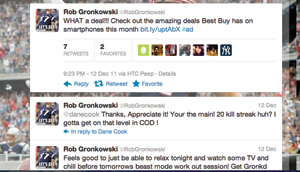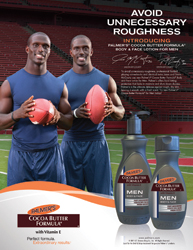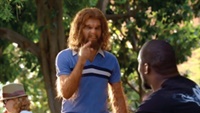With seemingly every professional athlete using Facebook and Twitter these days, it shouldn’t come as a surprise that many are using those efforts as means to make money. While some fans may not like it, it’s become a reality that will only continue to become more prevalent as time goes on.
Endorsements have been a part of sports for decades. The phrase “you can run, but you can’t hide” is appropriate for ads these days, as just a few years ago people viewed TiVo as the genius invention that would help them escape ads. However, advertisers found their way back into people’s living rooms, this time via a couple of their most heavily consumed leisure destinations: Facebook and Twitter.
When New England Patriots tight end Rob Gronkowski recently sent out an advertised tweet, as countless athletes do regularly, the feedback I observed indicated a consensus that the tweet was overly cheesy. Furthermore, some business minds went as far as referencing Gronkowski’s tweet to conclude that paid athlete tweets weren’t part of the future. While I don’t believe ads as forced and cheesy as this one will ultimately provide sponsors with the type of ROI they’re looking for, I do, however, believe that paid athlete social media posts of a more sophisticated nature are an enormous part of the future sports marketing landscape.
 |
| Paid tweets, like this one from Patriots tight end Rob Gronkowski, are often criticized for being overly commercial. Pairing a paid tweet with multimedia could remove that stigma. |
Where Gronkowski’s tweet went wrong more so than the typical paid athlete tweet was that he followed it up with a not-so-subtle “Oops, what was that?” tweet just three minutes later, essentially destroying any potential credibility the brand was seeking in paying him for his tweet. While I don’t blame him, since he got paid regardless, I think Gronkowski’s case is the perfect example of why brands need to think more creatively about the perceived authenticity of the messaging they’re having athletes post while placing some parameters on their preceding and subsequent posts.
Given the growing number of companies that specialize in matching athletes (and celebrities) with brands for paid status updates/tweets on both Facebook and Twitter (i.e. ad.ly, IZEA, and Twtmob), paid athlete tweets as we now know them are only the tip of the iceberg. I don’t blame athletes for occasionally cashing in on these opportunities, as some of my clients have done, but I believe that immediate changes need to be made, both philosophically and tactically, by the brands paying for these endorsements.
With the exponential growth of Facebook and Twitter, people are consuming more of their entertainment and news there via their computers and cellphones, meaning if you’re a brand that wants eyeballs on your partnership with an athlete, you better figure out how to do so via social media. As I look toward the future, several things must change in order for paid status updates/tweets to prove beneficial to both the sponsors and the
 |
| Memorable endorsements carry vivid images, like Brian Orakpo and the Geico caveman and the McCourty twins with Palmer’s. Social media ads should take note. |
athlete endorsers, and it begins and ends with multimedia.
Think for a moment about the last athlete endorsement you saw. Was it a K-Swiss TV commercial with Patrick Willis or a Geico commercial with Brian Orakpo? How about a Palmer’s Cocoa Butter ad in ESPN The Magazine with twins Devin and Jason McCourty? Odds are, whatever it was featured the face and/or voice of the athlete endorser, as I believe that creating a memorable visual experience is the staple of successful sports marketing.
While most things in life are constantly evolving, including social media, other things remain the same. One of those things that I believe remains the same, and always will, is that human nature causes us to respond in a more profound, impactful way when presented with face-to-face interaction, including video and picture consumption.
Though I recognize they exist, it’s very rare to see an athlete endorsement that simply displays a quote in text form without an accompanying picture or video. This being the case, why have paid status updates/tweets been almost exclusively text-based to this point? I believe it’s because social media is still in its infancy, with no one truly knowing what all of the metrics mean, and thus not having a definitive way to determine their ROI. Companies that have delved into this paid status updates/tweets business are still testing the water and thus are taking it slow. While I can understand that, it’s time to recognize that the influence of many athletes’ social networks makes them worthy of social endorsements and that the delivery of these endorsements needs to become more social in nature.
The best way to execute this, both from the athlete’s and endorser’s perspective, is to present a more authentic, genuine advertisement to consumers via aforementioned multimedia, such as videos and pictures. In regard to the aforementioned Gronkowski tweet, the brand requiring him to include a simple picture of a cellphone would have been a vast improvement, in addition to changing the verbiage, instead of making him look like a used car salesman. If multimedia and better copy are adopted, fans will take these endorsements more seriously instead of responding with complaints about being spammed, which is a lose-lose for both the athlete and the brand. By showing fans instead of telling them, the result will be athletes receiving more meaningful feedback on the campaign, which of course will result in a stronger ROI for brands, even if they can’t tangibly measure it … yet.
Jeff Weiner (jweiner@esblsocialmedia.com) is CEO of ESBL Social Media Coaching and coaches athletes, personalities and organizations on social media strategies.







